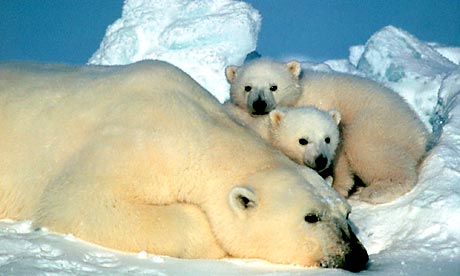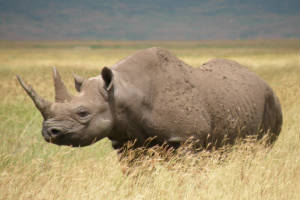Polar bear cubs drowning due to sea ice loss, says report
Reprinted from: Guardian Environment Network
Bruce Barcott for OnEarth, part of the Guardian Environment Network
Tuesday 19 July 2011 10.25 EDT
Polar bear cubs in Alaska are drowning on long swims with their mothers because of melting sea ice, a new study finds.
Polar bear cubs in Alaska are drowning on long swims with their mothers because of melting sea ice, a new study finds.
 |
Polar bear with cubs in the Arctic National Wildlife Refuge in Alaska. Photo: AP |
Biologists studying polar bears off the coast of Alaska have found that when cubs are forced to go on marathon swims with their mothers due to loss of sea ice, nearly half of them don't survive the journey.
The study, scheduled to be announced at the International Bear Association Conference in Ottawa on Tuesday, confirms the dangers of ice loss to Alaska's polar bear population. It's been widely theorized that adult polar bears have been forced to cross ever-longer stretches of open ocean as the polar regions heat up.
The new work, by U.S. Geological Survey Alaska Science Center researchers Anthony Pagano, Kristin Simac, George Durner, and Geoff York, confirms that theory. It also reveals that these open-water swims have a dramatic effect on young cubs, which are forced to follow their mothers in search of food and solid ground.
The data that led to those findings was a bit of a surprise. "This came to us purely by accident," said York, who worked for the USGS in Alaska from 1996 to 2008. His work there was critical in the U.S. Fish & Wildlife Service's 2008 decision to list polar bears as threatened under the Endangered Species Act. (York is now an Arctic species specialist for the World Wildlife Fund.)
Every spring, USGS researchers catch and collar adult female polar bears in the Beaufort Sea and Chukchi Sea and follow their movements through GPS tracking. "Because of their body shape, the collars just don't stay on the males," York said. "And it's too dangerous to collar young sub-adults because they grow too quickly. The collar could become a choking hazard. So much of what we know is based on the movement of female bears - where the girls are."
In 2004, a new type of collar began working erratically. "We were getting these unexplained gaps in transmission," York recalled. "I took those gaps and overlaid them on maps of sea ice coverage." There seemed to be a correlation between gaps in each bear's track and the loss of sea ice.
That's when the scientists realized that the new collars happened to be designed with the GPS transmitter on the lower half of the collar, which submerged when the bears were swimming. Water blocked the signal -- hence the data gaps (a theory they later confirmed with new technology).
Pagano and York collected data from 68 GPS collars over a six-year stretch from 2004 through 2009. Each collar has a battery that lasts about a year, and is programmed to unlock and fall off near the end of the battery's life. They looked at each mother bear's swimming record and found 50 long-distance swimming events (more than 30 miles) involving 20 bears over those six years. One bear swam 426 miles. Another was in open water for nearly 13 straight days.
Eleven bears that swam long distances had young cubs at the time of the collar deployment. Five of those bears lost their cubs while swimming, a 45 percent mortality rate. Among cubs not compelled to swim long distances, the mortality rate was 18 percent.
"Adult polar bears are strong swimmers," York said. "But they can't hold their noses while swimming, so they're at risk for drowning if a storm hits. Cubs are at even greater risk. Their smaller body size leaves them more prone to hypothermia, and they don¹t have the energy reserves of the adult bear. They can't feed while swimming, and it takes a lot of energy to keep up with mom."
This June, less sea ice covered the Arctic than in any year, save one, since records began being kept in 1979. And because of heavy melting in July, the National Snow and Ice Center in Boulder, Colorado, reports that 2011 is now on track to drop below the record low-ice minimum set in 2007.
Arctic sea ice usually reaches its lowest point during the first week of September, which means those cubs may be doing a lot more swimming this summer.
------------------------------
Black Rhino Now Extinct in the Wild
No wild black rhinos remain in West Africa, according to the latest global assessment of threatened species.

The subspecies of the black rhino -- which has been classified as "critically endangered" by the International Union for Conservation of Nature's (IUCN) Red List of Threatened Species -- was last seen in western Africa in 2006.
The Red List has declared the subspecies extinct.
A subspecies of white rhino in central Africa is also listed as possibly extinct, the organisation says.
The annual update of the Red List now records more threatened species than ever before.
The IUCN reports that despite conservation efforts, 25% of the world's mammals are at risk of extinction. As part of its latest work it has reassessed several rhinoceros groups.
As well as declaring the western black rhino (Diceros bicornis longipes) extinct, it records the northern white rhino (Ceratotherium simum cottoni), a subspecies in central Africa, as being on the brink of extinction.
The last Javan rhino (Rhinoceros sondaicus) outside Java is also believed to have disappeared.
Overall numbers of black and white rhinos have been rising, but some subspecies have been particularly vulnerable to poaching by criminal gangs who want to trade the animals' valuable horns.
Simon Stuart, chair of the IUCN Species Survival Commission, told BBC News: "They had the misfortune of occurring in places where we simply weren't able to get the necessary security in place.
"You've got to imagine an animal walking around with a gold horn; that's what you're looking at, that's the value and that's why you need incredibly high security."

To understand more about why species extinction is such a tragedy, see this previous blog posting.

